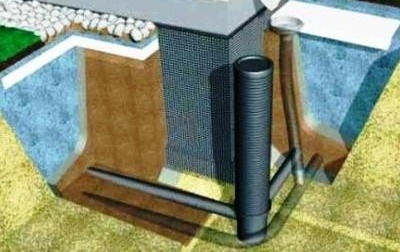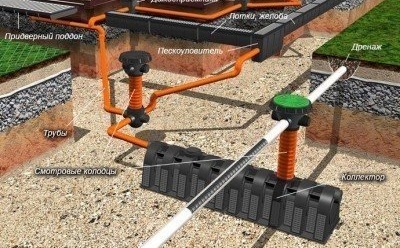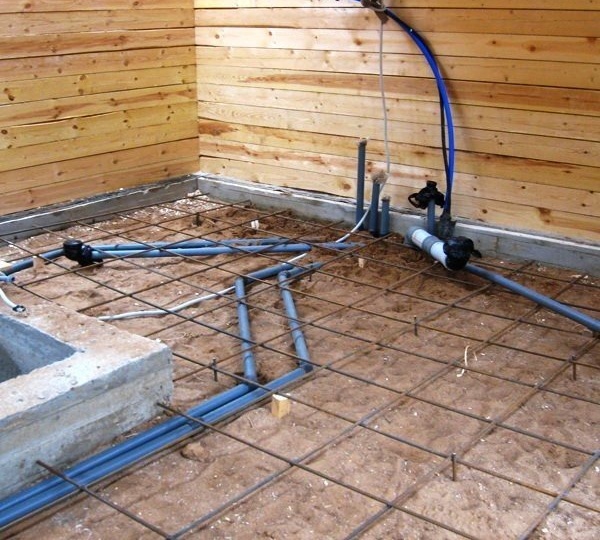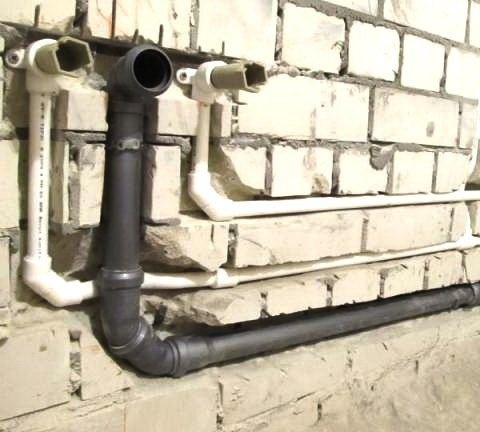Do-it-yourself storm sewer - an example of work from "A to Z"
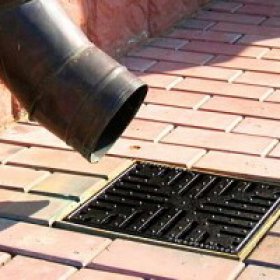
The charms of a poorly functioning city rainfall are probably familiar with your favorite shoes. Often, after a "tight" meeting with deep puddles accumulated on the asphalt, beloved shoes and boots leave only pleasant memories and photographs about themselves. For a city dweller, the loss of shoes is the maximum damage, the damage to the owner of a country house is more widespread. In order that atmospheric water does not slowly but persistently destroy the foundation, does not flood the basements, and does not contribute to rotting of the plant root system in the area, water drainage is required. A not-too-difficult do-it-yourself sewage can be organized by a contractor who has nothing to do with construction specialties.
Content
Purpose and specifics of the stormwater device
Storm sewage is a complex of devices and channels that collects, filters and removes atmospheric moisture into filtration fields, special reservoirs, and reservoirs. Its task is to eliminate excess moisture, creating discomfort, destroying structures and shortening the life cycle of plants.
Stormwater is a linear network that includes such standard elements as:
- storm water inlets represented by funnels, pallets, linear trays that collect water;
- gutters, pipes, trays transporting water to sand traps - filtration devices, and further to collectors, ditches, ponds, to unloading fields;
- manholes required to control the storm system;
filters, sand traps that hold soil particles, plant fibers and debris that protect the network from pollution.
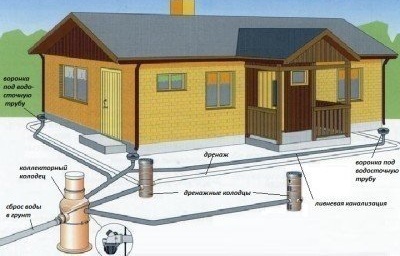
The stormwater system is a complex of channels and devices that collect excess atmospheric moisture, filter it and discharge it first to the collector well, then to the discharge points
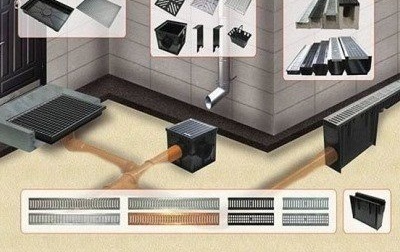
Variants of storm water inlets for stormwater installation: on the left is a door tray, in the middle it receives water from a drain funnel, on the right is a gutter with a sand trap
All elements are combined into a single system that works on linear or point technology. If storm sewer channels are laid in the ground, pipes are used for their construction. In the surface ditches, gutters and trays of plastic, asbestos or concrete are installed.
Important. To ensure the natural movement of rain and melt water to the places of filtration and unloading, pipes, trays, gutters are laid with a slope towards the drainage devices and places of unloading.
Classification by way of collecting wastewater
Depending on the principle of collection, according to which the storm sewer is installed, all existing stormwater are divided into two types.
- Point systems, which include storm water inlets, installed under the gutters of internal and external drains. Each atmospheric water receiving device is connected to a common trunk. According to technical conditions, storm water inlets are equipped with special gratings and sand traps that prevent the penetration of suspended particles of soil, plant debris, and debris into the system.
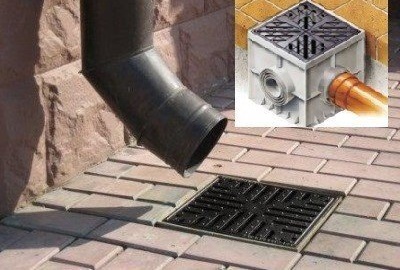
Spot type of stormwater: a storm water inlet is installed under the drain, a water-receiving funnel is equipped with a filter net and an internal litter box
- A linear type of storm shower, which is a network of channels laid underground or in slightly deepened trenches. Open water trays that collect and move water are also equipped with sand traps and grates. Only grilles are installed along the entire line. Unlike the point scheme, linear sewage collects water not only from roof gutters, but also from paths, from concrete-covered platforms, paved with paving bricks. This type of sewage system “covers” and processes more objects.

The linear scheme of stormwater can cover a large territory, to drain drains not only from the roof, but also from landscaped areas, from sidewalks, and from those sides of the house where, due to the specificity of the pitched structure, there are no drains
Based on the design differences and the degree of coverage of the territory, the type of system is selected. However, these are not fundamental selection criteria. Basically, storm sewage in the country is arranged according to the experience in the organization and operation of storm sewers available in a particular area. Based on it, they determine the type of channel laying and the depth of their laying.
Preliminary calculations and design
Implementation of plans without settlement - money down the drain. If the system cannot cope with the function assigned to it by the owner, you should not undertake its construction at all, and a too powerful storm sewer of a private house will “eat” a lot of financial resources.
Video: design and installation rules
Information required for calculations
- Data on the average amount of precipitation recorded by meteorologists in a particular area. You can find them in SNiP 2.04.03-85.
- The frequency of rains, the power of the snow cover, necessary for those who plan to use the system and to drain melt water.
- Drain area. For a point variety, this is the area of the roof. Moreover, not the full value, but the value of its projection in the plane. For a linear system, the drainage area will be the sum of the areas of all processed objects.
- Physico-mechanical characteristics of the soils available on the site.
- The presence and location of existing communications already located on the site.
Calculation of the volume of effluents
The above exact values of the amount and intensity of precipitation are the result of many years of research into physical phenomena in the atmosphere of a given area. You can find them in SNiP or get in the local weather service. Further calculations are performed according to the formula.

Formula for calculating the flow of atmospheric water, as well as the constants and variables used in the calculations
Correction factor used in this formula:
- 0.4 for rubble-covered areas;
- 0.85 for concreted sites;
- 0.95 for paved areas and paths;
- 1.0 for roofs.
The volume value was obtained, then the required pipeline diameter is determined from the tables of the current SNiPa.
Channel depth
It is necessary to lay the trays or channels from the pipes at the depth at which they are usually laid in this region.The exact value can be found out in the construction organization or inquired from neighbors who have already equipped their site with storm water. In the middle lane, a rainwater drainage system is usually arranged at a depth of 0.3 meters, if the diameter of the pipeline or open trays is not more than 50 cm. Trays and pipes with larger dimensions are buried by 0.7 m.
An important point. If the site has a drainage system, storm sewers are laid above the drainage.
The high cost of excavation usually does not stimulate the desire of professional installation customers to go deep into the ground. Even if it is decided to make a storm sewer device with your own hands, it makes no sense to bury it too deeply. There is no reason to install collectors and manholes below the level of seasonal freezing, according to state standards. They can be positioned higher, insulated with heat-insulating material - geotextiles and a layer of rubble that protects the network from freezing. Due to insignificant deepening, the complexity of the work is significantly reduced.

In case of slight deepening, warming of storm sewers is carried out from a layer of geotextile and a layer of crushed stone, thanks to the protection of channels from freezing, you can significantly save on earthwork
However, we must not forget that the channels to the collection and cleaning devices must be angled. This means that the level of the entry point into the collector well should be lower than the level of the tray or pipe extending from the storm water inlet. To accurately calculate the depth of their installation, you need to draw a plan of the site and taking into account the slope of the channels, calculate everything.
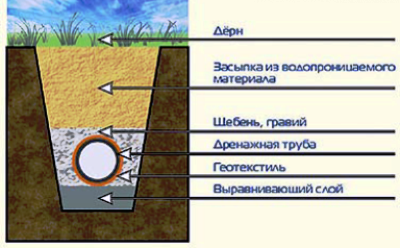
The scheme of the stormwater device, the channels of which are laid below the freezing depth, the insulating geotextile protects in this case from groundwater aggression
Slope Standards and Norms
GOST regulates the minimum slope for pipes with a 150 mm diameter of 0.008 (the slope in mm / m). Pipes having a cross section of 200 mm are laid at an angle of 0.007. Depending on the conditions of the site, the slopes of the pipes may vary slightly. The largest slope is 0.02 in the area where the canal connects to the storm water inlet, since in this place it is necessary to increase the speed of gravity of water. Before the sand traps, the flow velocity must slow down so that the suspended particles can “settle”, the tilt angle there is the smallest.
Devices for collecting water in envelope-type systems with storm water inlets-funnels are installed at the intersection points of the slopes.
The process and specifics of installing stormwater
The rules for installation work on the installation of stormwater are identical to the principles of laying conventional outdoor sewer pipelines. However, if the house is not equipped with drains, you need to start with their device.
Roofing component construction
- In the ceilings of the house, you need to make holes for storm water inlets. After installing the devices and their fastening on the bitumen mastic, the junction must be sealed.
- Sewers and risers are mounted.
- All elements must be attached to the structures of the house with the help of clamps.
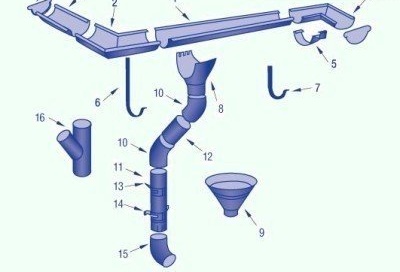
Scheme of the roofing part of stormwater: 1. gutter; 2. the angle of the gutter is external; 3. the angle of the gutter; 4. gutter plug; 5. gutter connector; 6. hook; 7. hook; 8. funnel; 9. The drainage funnel; 10. pipe bend; 11. drainpipe; 12. connecting pipe; 13. pipe bracket (for brick); 14. pipe bracket (on wood); 15. knee drain; 16. pipe tee
Next, set the trays, if a linear type of system is being built, or branch pipes, if the installation is carried out according to the point scheme.
Underground unit
According to the planned plan, drawn up taking into account the slopes and the depth of the channels laid down in the region, it is necessary to dig a trench.If it is supposed to insulate the pipeline by forming a shell of geotextiles and rubble around it, or to arrange a pillow of sand, their power should also be taken into account. Here's how to proceed:
- The bottom of the trench is carefully rammed before installation. Large stones encountered during digging are removed; pits formed after their removal are covered with soil.
- A sand cushion is poured at the bottom, its standard thickness is 20 cm.
- A foundation pit is being formed for the installation of a collector tank. As a collector, it is easiest to use a ready-made plastic container, but if you wish, you can make a collector well yourself, pour concrete into a pre-arranged formwork.
Pipes are laid in tamped and equipped with sand cushions ditches; fittings are used to connect them into a single system.
- It is recommended that viewing wells be included in the direct branches of a storm shower with a length of more than 10 m.
- Sand traps must be installed at the points where the collectors and pipelines receiving atmospheric water are joined.
- All devices and devices are connected in one circuit, the joints of the components are sealed.
Before filling the trench, it is necessary to conduct tests by pouring water into the water inlets. As a result of testing, no weak points were found? We fill the soil with the system laid in the trench, and we equip the gutters, trays, pallets with grates.

Before filling the trench, the constructed system must be checked, identified and eliminated, all defects and leaks, if they occur
Tip. Pitched roof structures are not equipped with drains on all sides. Where there are none, it is recommended that gutters with gratings be installed and included in a common network.
It is forbidden to unload the city sewer well into the general sewer network due to the presence of chemicals and oil products in the effluents. The owner of a country house can freely connect the stormwater to his sewage system, because there are no hazardous components that require fine cleaning.
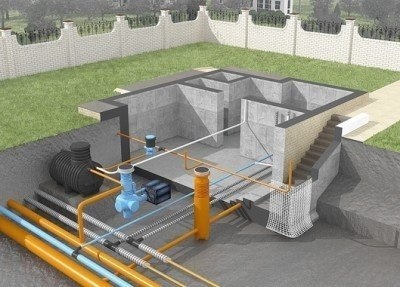
After cleaning in the sand trap, water enters the sewer, from there it can be distributed directly into the ground, unloaded into ponds or into the ordinary sewer network of a private house
Improvement of the house and the surrounding area with a surface drainage system will help to extend the life of structures, save puddles and slush of owners, and prevent rotting of plant roots. A simple storm of the site with your own hands can be mounted by the owner himself, but even in the case of contacting the builders, information about the specifics of its organization will not interfere. The owner himself will be able to trace the violations, and repair, and clean.
